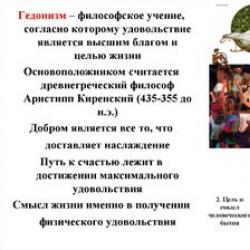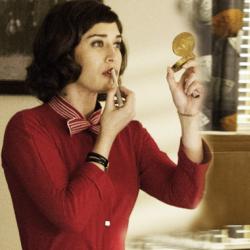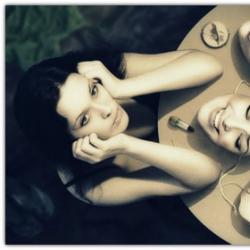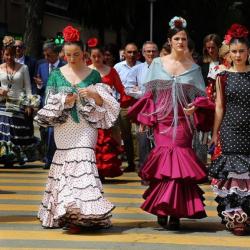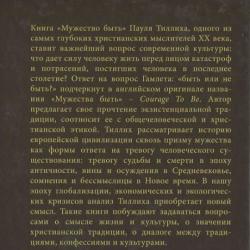Fresco and mosaic compositions. Presentation on the theme "Roman mosaics.". Questions and tasks
Characteristic features Splendor of decorative compositions Splendor of decorative compositions Richness of plots Richness of plots Variety of artistic techniques Variety of artistic techniques Mastering aerial perspective Mastering aerial perspective Expanded image of the human environment Expanded image of the human environment

Characteristic features Directness of perception of the surrounding world Directness of perception of the surrounding world The desire to show a real person, his inner world and physical beauty The desire to show a real person, his inner world and physical beauty




Portrait of Paquius Proculus and his wife Circa CE. e. Height 58 cm Fresco Naples.



Christ is a solar deity. Mosaic of the tomb of Julia, discovered under the Cathedral of St. Peter's years n. e. Rome







Winter. Mosaic of the composition "The Four Seasons" from El Jem, Tunisia Second half of the 4th century AD. e.


Lion head. Mosaic of a villa near Piazza Armerina, Sicily AD e.


Creative Activity Roman culture is similar to Greek culture in many ways. And can it be called unique and unrepeatable? Some scholars consider Roman civilization imitative and too utilitarian, seeing it as the last stage of a single Greco-Roman, or ancient, civilization. Others claim. That Rome created a peculiar, original civilization with its own system of values. Roman culture is similar to Greek culture in many ways. And can it be called unique and unrepeatable? Some scholars consider Roman civilization imitative and too utilitarian, seeing it as the last stage of a single Greco-Roman, or ancient, civilization. Others claim. That Rome created a peculiar, original civilization with its own system of values. What is your opinion? What is your opinion?

In ancient Rome, mosaics were widely used to decorate the interiors of public buildings and private houses. The demand for it was very high, so the quality could be different.
The mosaic was made from natural stone...
Or smalt - colored glass.
Unlike Ancient Egypt, Mesopotamia and other ancient civilizations, in Ancient Rome, as well as in Ancient Greece, the three-dimensional principle of the image was used. 
In ancient Roman painting, including mosaics, almost all genres are used.
The most popular were mythological and everyday genres.
Odysseus. Mosaic from the House of Odysseus and Dionysus in Dougga. 3rd century
This mosaic can be attributed both to the everyday genre and to the group portrait.
Philosophers. Mosaic from the Naples Archaeological Museum.
The historical genre is much rarer, but what a quality! 
Battle of Ise. Pompeii.
Portraits, especially those of women, are often idealized. 
Still life is one of the most popular genres. Seafood is especially loved.
II century. Museum of the Vatican.
Roman artists depicted birds and animals very often.
They are always recognizable and very expressive.
Mosaic from the Naples Archaeological Museum.
Mosaic paintings were often surrounded by a wide ornamental frame.
Mosaic from the British Museum.
Ornamental mosaics proper were also not uncommon. The variety of ornaments is amazing.
slide 2
Roman mosaic - a type of mosaic made from small cubes of stones of different colors or smalt, the small size of the modules makes it possible to achieve high accuracy and elegance of the image. This technique is also used in arts and crafts, it has existed since ancient Rome. Neptune driving a chariot.
slide 3
History: The Romans adopted the mosaic from the ancient Greeks. The earliest known examples of Roman mosaics are found in Delos and date back to the 2nd century BC. e .. The art of mosaic began to develop actively during the reign of Julius Caesar and Octavian Augustus, when great wealth began to flow to Ancient Rome from the conquered territories. Mosaic Hylas and the Nymphs. Multi-colored stone, marble. End of the 3rd - beginning of the 4th c.
slide 4
The first mosaics were quite simple and limited to geometric designs. With the growth of skill, anthropo- and zoomorphic images and plot compositions became the most popular. Every wealthy Roman had at least one mosaic in his house, which most often decorated the floor and walls. Julius Caesar ordered to pave the floor with mosaics in his temporary dwelling, even during campaigns.
slide 5
Pliny the Elder mentions in the Natural History of the Pergamon artist Soza, who depicted life-size remains of a feast on the floor in mosaic technique: bones, crab claws, fruits and vegetables, shells. Another well-known work of the master is the mosaic "Doves on the Bowl".
slide 6
In Pompeii, mosaics with the image of a dog and the inscription Cavecanem ("beware of the dog") were found, which warned uninvited guests that the house was guarded by a dog. These mosaics were usually laid out on the road in front of the house and were done in black and white. Most often, dogs were depicted on a chain and with a grin, less often - curled up in a ball.
Slide 7
The most famous Roman mosaic from Pompeii is the Battle of Issus, depicting Alexander the Great in battle with the Persian king Darius III. The mosaic was found on the floor in one of the rooms of the Faun's house. The original size was 313×582 cm, but some of the fragments have not been preserved.
Slide 8
In the III century AD. The Roman Empire was going through a deep political and socio-economic crisis. In order to hide the real state of affairs from the plebs, the upper strata of the population spend huge sums on feasts and external gloss. Mosaic is getting even more widespread use. The luxurious baths of Caracalla, built at the beginning of the 3rd century, were richly decorated with mosaics, sometimes with gilding.
Slide 9
Mosaic technique The first mosaics were made using the pebble paving technique, in which whole pebbles were used. Then more often they began to split the pebbles into smaller fragments (tesserae), from which more accurate, refined images were obtained. In a piece mosaic, unlike the above-mentioned techniques, plates of various sizes and shapes are used (usually the central element is a single plate, smaller tesserae frame it). Marble on the floor of Hadrian's Villa
Slide 10
The color palette was expanded through the use of such natural materials as marble, slate, multi-colored limestone, semi-precious stones. However, these materials were quite expensive, so the craftsmen were still content with pebble colors. With the discovery of cheaper glass as a mosaic material, the work became more artistic and vibrant. Smalt has become a traditional material for creating mosaics. Mosaic "June". Multicolored stone, smalt. 3rd century
View all slides
To use the preview of presentations, create a Google account (account) and sign in: https://accounts.google.com
Slides captions:
Artistic culture of Ancient Rome
General characteristics of culture The history of Ancient Rome spans more than 12 centuries (from the 8th century BC to the 5th century AD). She left the richest cultural heritage to mankind: architecture, sculptural portrait, frescoes, mosaics, poetry of Virgil and Horace, oratory, legal system, philosophy, theatrical art. In many ways, the Romans adopted art from the Greeks, when in the 1st century BC. conquered her.
Three main periods are distinguished in the development of the artistic culture of Ancient Rome: Etruscan culture (7th -4th centuries BC). The era of the Roman Republic (6th - 1st century BC). The era of the Roman Empire (1st century BC - 4th century AD). During the period of the emergence of the Roman state itself, its culture was completely based on the principles of Etruscan culture.
Architecture of Ancient Rome Represented by Cities, Palaces, Temples, Paved Roads, Bridges
Architecture of the period of the Roman Republic
Roman Forum The cities were located on huge 4 - coal squares - forums. The center of business and social life is the Roman Forum, to which all the streets of the city converged. Trade deals were concluded here, courts and people's meetings were held.
Trajan's Column The most remarkable monument in the Forum was the 38-meter Trajan's Column. From top to bottom, the column is covered with reliefs telling about the military campaigns of Trajan. At the base of the column, a room with a golden urn was found, where the ashes of the emperor are kept. Inside the column is a spiral staircase with 185 steps leading to the top. Previously, the column was decorated with a statue of Trajan, but it was lost and replaced by a statue of St. Peter.
Over time, the Forum was abandoned, part of the building material was used by residents for their own purposes. Most of the buildings were destroyed forever. In the Middle Ages, cattle grazed on this site, and subsequently the Forum was completely lost. Only at the beginning of the 20th century, archaeologists managed to partially restore this complex.
Temple of Vesta at the Bull Market Almost nothing has been preserved from the architectural monuments of the republican period. The best buildings of this time are the Temple of Fortune Virilis and the Temple of Vesta in the Bull Market, which clearly reflect the features of Greek culture.
Roman architecture strives to satisfy human needs. Engineering structures can be distinguished into a special group: aqueducts (water pipelines), huge viaducts (bridges) and roads.
Pont du Gard, Roman viaduct with aqueduct in the upper tier
The Appian Way The Appian Way is paved with rubble and concrete slabs with the addition of volcanic ash. Well preserved to our time.
Architecture of the Roman Empire
Among the architectural structures of the era of the Roman Empire, spectacular buildings are of particular interest. The largest of them is the Colosseum, where performances were played, gladiator fights were held, wild animals were tamed. The Colosseum is a huge oval bowl. In the center of the Colosseum is an arena surrounded by stepped benches for spectators, whose number sometimes reached 50,000.
One of the masterpieces of Roman architecture is the Pantheon (temple of all gods), the construction of which was completed in 125. There are no analogues of the Pantheon even in the modern world. The main attraction is the dome 43 meters in diameter. Currently, the tomb of the great people of Italy has been created in the Pantheon.
The triumphal arch of Emperor Titus marked his victory over the rebellious Judea. The span of the arch is decorated with reliefs on both sides. Triumphal arches originated in Rome and were later adopted by other cultures. But one way or another, they mean the valiant victories of influential people.
Among the largest public buildings of Ancient Rome, it is necessary to name the buildings of the term (public baths), which are an integral part of any city. There were about 12 imperial baths in Rome. The baths served as a place of rest and visiting them was part of the daily life of the Romans. The most famous terms were created by the emperor Caracalla in the 3rd century.
Baths of Caracalla
Questions and tasks What influence did the art of ancient Greece have on the formation of Roman culture? What is their difference? Describe one of the masterpieces of Ancient Rome: the Forum, the Pantheon, the Colosseum. Why do you think the Forum and other buildings were destroyed, but the Pantheon remained intact? What were the public buildings of ancient Rome used for?
Roman mosaic is an artistic art that originated in ancient Rome, which is a mixture of the culture of Greece and Byzantium. Initially, these were drawings on walls, paths and floors, ceilings, made with pebbles. Then the mosaic pictures were made of glass. Over time, the processing of stones and glasses improved, the images became clearer and more legible. Thus, in the ancient Roman state, palaces and houses of wealthy people were decorated, portraits of people were made, hunting, war and other pictures were painted.
The art of mosaics on the walls of buildings made of stones was learned by the Romans from the Greeks, who practiced this method of decorating buildings from the second century BC. e. The heyday of this direction fell on the period of successful military campaigns of Julius Caesar and Octavian Augustus, when the empire grew rich due to the collection of contributions. In the ancient Roman state, craftsmen were called from Greece to work and train apprentices. Thus, the state on the Apennine Peninsula received the heritage of the mosaic culture from Hellas.
Roman mosaic
At first, the drawings were very primitive and consisted of geometric shapes and lines. The craft of mosaic was gradually improved, and the masters learned to depict people and animals on wall paintings with the help of stones. The paving technique became more complicated - the drawings became more and more complex, the materials changed and improved: they depicted hunting, theatrical and military actions.
Works made in more complex techniques, such as opus sectile, were available to wealthy people in whose houses walls, floors, and ceilings were decorated in this way.
Mosaic drawings were used not only to decorate dwellings, but also for warnings - inscriptions, for example, that a dog lives in the house and guards it. The words "Cave canem", meaning "Beware of the dog", were accompanied by a picture on the path to the house.
Known for the painting made in the mosaic technique depicting Alexander the Great and King Darius the third "Battle of Issus". She was preserved in Pompeii in the house of a Faun.
In the 3rd century AD, an economic crisis broke out in the Roman Empire. Oddly enough, at this time the art of mosaic drawing was most powerfully developed, as the rich and powerful people sought to hide the onset of default from ordinary people. The external splendor of the Roman palaces of the patricians hid the troubles of the economy of the great empire from the plebeians.
Technique and images
At first, Roman mosaics were made up of single pebbles. This technique was called "barbarian". The improvement in the processing of stones made it possible to use carved even fragments of stones for the image, due to which the pictures became more and more clear.

National Museum of Bardo, Tunisia. Roman mosaic. Odysseus listens to the Sirens.
There are four known techniques for making wall and floor drawings of ancient Roman mosaics from processed stones:
- Opus tessellatum. Fragments larger than 4 mm. Large mosaic.
- Opus vermiculatum. The size of the elements of the picture is less than 4 mm. The Roman mosaic turned out to be more detailed and clear.
- Opus sectile or Florentine. With this technique, fragments of various sizes are used: both solid stones and processed ones. As a rule, the raw element was placed in the center, framing it with small stones or glass.
- Opus regulatum. Equal elements were formed into a pattern of regular geometric shape, like a chessboard.
Compared to all-stone paving, the opus tessellatum technique left less wide seams between its elements. The gaps between the stones were painted over with paint to match the fragments. They also used colored glass - smalt, made from silicic acid and cobalt.
With the Opus vermiculatum technique, the seams between the chipped stones (tesserae) were also tinted. Pictures become clearer by reducing the size of the constituent elements. The Sicilian “Hunting Scene” and “Doves on a Bowl”, “Inhabitants of the Deep Sea”, “Rider on a Tiger”, “Breakfast of a Woman” in Pompeii were made in this technique.
Roman mosaic in the opus sectile style is a younger technique that appeared due to the desire to save material by creating plates from stone. "Tiles" and laid out the desired image. This method required large material costs due to its technical complexity of stone processing. Roman mosaics in the opus sectile style adorned the homes of very wealthy gentlemen.
The opus regulatum technique created geometrically correct patterns and was used for paving roads.
In addition to pebbles, semi-precious stones, marble, limestone, crushed stone, glass (smalt) were also used. The latter, due to its cheapness and effectiveness, has become the most common material for making images. Glass was used to create ceiling, wall and floor mosaic paintings. These works adorned the temples of the gods and the palaces of the patricians.
Smalt was made from cobalt and silicic acid, it was given shades. This multi-colored glass seemed to glow from within. The manufacture of smalt was cheap. And the appearance could imitate precious and semi-precious stones.
Conclusion
Mosaic in ancient Rome marked the beginning of the development of ceramics, but at the same time remained an independent art, passed down to posterity. Currently, this method of decoration (especially opus sectile) is used in the decoration of temples and apartment interiors. Now more modern materials are used: glue, paints.

